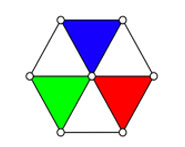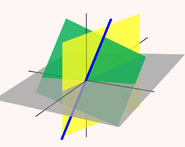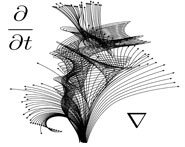


 تاريخ الرياضيات
تاريخ الرياضيات
 الرياضيات في الحضارات المختلفة
الرياضيات في الحضارات المختلفة 
 الرياضيات المتقطعة
الرياضيات المتقطعة
 الجبر
الجبر
 الهندسة
الهندسة 
 المعادلات التفاضلية و التكاملية
المعادلات التفاضلية و التكاملية 
 التحليل
التحليل
 علماء الرياضيات
علماء الرياضيات |
Read More
Date: 7-4-2021
Date: 24-2-2021
Date: 7-2-2021
|

The Buffon-Laplace needle problem asks to find the probability  that a needle of length
that a needle of length  will land on at least one line, given a floor with a grid of equally spaced parallel lines distances
will land on at least one line, given a floor with a grid of equally spaced parallel lines distances  and
and  apart, with
apart, with  . The position of the needle can be specified with points
. The position of the needle can be specified with points  and its orientation with coordinate
and its orientation with coordinate  . By symmetry, we can consider a single rectangle of the grid, so
. By symmetry, we can consider a single rectangle of the grid, so  and
and  . In addition, since opposite orientations are equivalent, we can take
. In addition, since opposite orientations are equivalent, we can take  .
.
The probability is given by
 |
(1) |
where
 |
(2) |
(Uspensky 1937, p. 256; Solomon 1978, p. 4), giving
 |
(3) |
This problem was first solved by Buffon (1777, pp. 100-104), but his derivation contained an error. A correct solution was given by Laplace (1812, pp. 359-362; Laplace 1820, pp. 365-369).

If  so that
so that  and
and  , then the probabilities of a needle crossing 0, 1, and 2 lines are
, then the probabilities of a needle crossing 0, 1, and 2 lines are
 |
 |
 |
(4) |
 |
 |
 |
(5) |
 |
 |
 |
(6) |
Defining  as the number of times in
as the number of times in  tosses that a short needle crosses exactly
tosses that a short needle crosses exactly  lines, the variable
lines, the variable  has a binomial distribution with parameters
has a binomial distribution with parameters  and
and  , where
, where  (Perlman and Wichura 1975). A point estimator for
(Perlman and Wichura 1975). A point estimator for  is given by
is given by
 |
(7) |
which is a uniformly minimum variance unbiased estimator with variance
 |
(8) |
(Perlman and Wishura 1975). An estimator  for
for  is then given by
is then given by
 |
(9) |
This has asymptotic variance
 |
(10) |
which, for  , becomes
, becomes
 |
 |
 |
(11) |
 |
 |
 |
(12) |
(OEIS A114602).

A set of sample trials is illustrated above for needles of length  , where needles intersecting 0 lines are shown in green, those intersecting a single line are shown in yellow, and those intersecting two lines are shown in red.
, where needles intersecting 0 lines are shown in green, those intersecting a single line are shown in yellow, and those intersecting two lines are shown in red.
If the plane is instead tiled with congruent triangles with sides  ,
,  ,
,  , and a needle with length
, and a needle with length  less than the shortest altitude is thrown, the probability that the needle is contained entirely within one of the triangles is given by
less than the shortest altitude is thrown, the probability that the needle is contained entirely within one of the triangles is given by
 |
(13) |
where  ,
,  , and
, and  are the angles opposite
are the angles opposite  ,
,  , and
, and  , respectively, and
, respectively, and  is the area of the triangle. For a triangular grid consisting of equilateral triangles, this simplifies to
is the area of the triangle. For a triangular grid consisting of equilateral triangles, this simplifies to
 |
(14) |
(Markoff 1912, pp. 169-173; Uspensky 1937, p. 258).
REFERENCES:
Buffon, G. "Essai d'arithmétique morale." Histoire naturelle, générale er particulière, Supplément 4, 46-123, 1777.
Laplace, P. S. Théorie analytique des probabilités. Paris: Veuve Courcier, 1812.
Laplace, P. S. Théorie analytique des probabilités, 3rd rev. ed. Paris: Veuve Courcier, 1820.
Markoff, A. A. Wahrscheinlichkeitsrechnung. Leipzig, Germany: Teubner, 1912.
Perlman, M. and Wichura, M. "Sharpening Buffon's Needle." Amer. Stat. 20, 157-163, 1975.
Schuster, E. F. "Buffon's Needle Experiment." Amer. Math. Monthly 81, 26-29, 1974.
Sloane, N. J. A. Sequence A114602 in "The On-Line Encyclopedia of Integer Sequences."
Solomon, H. Geometric Probability. Philadelphia, PA: SIAM, pp. 3-6, 1978.
Uspensky, J. V. "Laplace's Problem." §12.17 in Introduction to Mathematical Probability. New York: McGraw-Hill, pp. 255-257, 1937.



|
|
|
|
"إنقاص الوزن".. مشروب تقليدي قد يتفوق على حقن "أوزيمبيك"
|
|
|
|
|
|
|
الصين تحقق اختراقا بطائرة مسيرة مزودة بالذكاء الاصطناعي
|
|
|
|
|
|
|
قسم شؤون المعارف ووفد من جامعة البصرة يبحثان سبل تعزيز التعاون المشترك
|
|
|